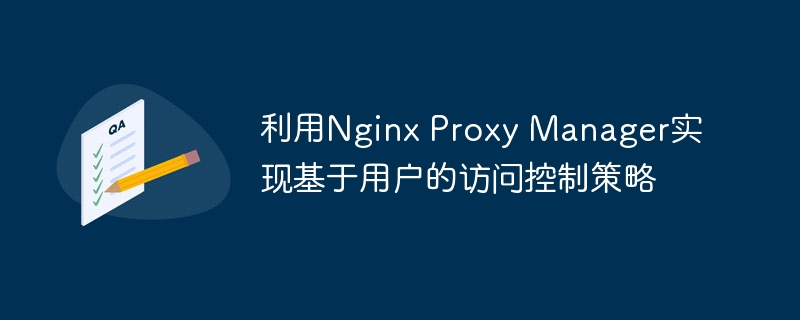

Use Nginx Proxy Manager to implement user-based access control strategy
Nginx Proxy Manager is a powerful proxy server management tool that is simple and easy to use based on Nginx The graphical interface can help us manage proxy services easily. In practical applications, we often need to control access to different users to protect sensitive information and resources. This article will introduce in detail how to use Nginx Proxy Manager to implement user-based access control policies and give specific code examples.
First, we need to install and configure Nginx Proxy Manager. You can download the latest version of the installation package from the official website https://nginxproxymanager.com/, and install and configure it according to the official documentation.
Next, we need to create a user list for access control. In the management interface of Nginx Proxy Manager, click the "Users" button in the left navigation bar, click the "Add User" button on the user management page, enter the user name and password, and check the "Admin" option (indicating that the user has an administrator permissions). Click the "Save" button to save user information.
Now, we can implement user-based access control policies by configuring routes and hosts in the management interface of Nginx Proxy Manager. Suppose we have two users, one is the administrator user admin, and the other is the ordinary user guest. We want to allow only administrator users to access website A, while ordinary users can only access website B.
First, click the "Proxy Hosts" button in the left navigation bar, and click the "Add Proxy Host" button on the host management page. In the new host page, follow the following steps to configure:
Next, we follow the above steps to create a host again, add a Location to it, and set the user name in the rule to guest.
After completing the above configuration, only the user named admin can access website A, and the user named guest can only access website B.
In the example, we use the user variables and access control rules provided by Nginx Proxy Manager to implement user-based access control policies. Through flexible configuration, we can perform fine-grained access control according to different user needs to protect sensitive information and resources. The code example is as follows:
location /websiteA {
location /
...
proxy_set_header User $remote_user;
...
}}
location /websiteB {
location /
...
proxy_set_header User $remote_user;
...
}}
In the above code , the $remote_user variable represents the user name of the client, and this variable is passed to the backend service through the proxy_set_header directive. We can then perform access control in the backend service based on the received user information.
To sum up, it is very simple to use Nginx Proxy Manager to implement user-based access control policies. We only need to configure routing and hosts in the management interface and authorize them through user variables and access control rules. This provides us with a flexible and convenient way to protect sensitive information and resources. I hope this article is helpful to everyone, thank you for reading!
The above is the detailed content of Use Nginx Proxy Manager to implement user-based access control policies. For more information, please follow other related articles on the PHP Chinese website!




